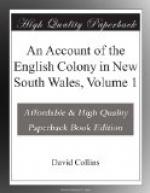The town of St. Sebastian (or, as it is more commonly named, the town of Rio de Janeiro, which was in fact the name of the river forming the bay, on the western side of which was built the town) is large, and was originally designed to have had an elevated and airy situation, but was, unfortunately for the inhabitants, erected on low ground along the shore, and in a recess almost wholly out of the reach of the refreshing seabreeze, which was observed to be pretty regular in its visitations. The inhabitants, nevertheless, deemed the air salubrious; and we were informed that epidemic distempers were rare among them. In their streets, however, were frequently seen objects of wretchedness and misery, crawling about with most painful and disgusting swellings in their legs and privities. The hospital, which had formerly been a Jesuit’s convent, stood near the summit of the hill, in an open situation, at the back of the town. From the great estimation in which English surgeons were held here, it would seem that the town is not too well provided in that respect. Senor Ildefonse, the principal in the place had studied in England, where he went under the course of surgical education called walking the hospitals, and might by his practice in this place, which was considerable, and quite as much as he could attend to, have soon realised a handsome fortune; but we understood, that to the poor or necessitous sick he always administered gratis.
The township of the Rio de Janeiro was said to contain on the whole not less than 40,000 people, exclusive of the native Indians and negroes. These last appear to be very numerous, of a strong robust appearance, and are brought from the coast of Guinea, forming an extensive article of commerce. With these people of both sexes the streets were constantly filled, scarcely any other description of people being seen in them. Ladies or gentlemen were never seen on foot in the streets during the day; those whose business or inclination led them out being carried in close chairs, the pole of which came from the head of the vehicle, and rested on the shoulders of the chairmen, having, notwithstanding the gaudiness of the chair itself, a very awkward appearance.
The language spoken here by the white people was that of the mother country—Portuguese. The ecclesiastics in general could converse in Latin; and the negro slaves spoke a corrupt mixture of their own tongue with that of the people of the town. The native Indians retained their own language, and could be distinctly discerned from the natives of Guinea, as well by the colour of the skin, as by the hair and the features of the face. Some few of the military conversed in French; but this language was in general little used.




